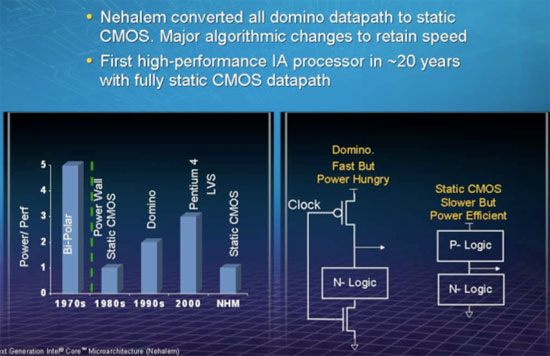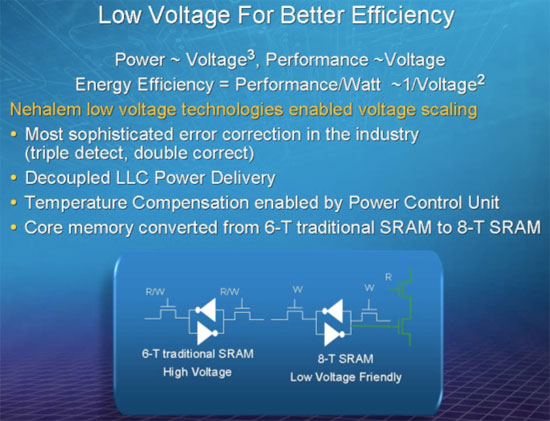The Dark Knight: Intel's Core i7
by Anand Lal Shimpi & Gary Key on November 3, 2008 12:00 AM EST- Posted in
- CPUs
Is Nehalem Efficient?
At this year's IDF in San Francisco, Intel revealed a little discussed but extremely important aspect of Nehalem's circuit design:

The Nehalem design is Intel's first microprocessor in the past two decades to feature absolutely no domino logic, it's a fully static CMOS design. I've explained the differences between dynamic domino and static CMOS design in the past, but simply put: domino logic is used as a clock speed play. It's incredibly useful in implementing very high speed circuit paths on a chip and hit its all time peak in Intel's usage in the Pentium 4 days. The downside to using such high speed logic is that it requires a lot of power, but in microprocessor design there are always tradeoffs to be made.

There are many other energy efficiency plays within Nehalem
In Nehalem, Intel took the new architecture as an opportunity to revamp its design, went in and removed all remaining domino logic - but without impacting the peak clock speed of the architecture. The tradeoff here is one of die size, by using more parallel logic Intel was able to convert some serial, high speed paths, into larger, slower circuits that removed the need for domino logic. Details are unfortunately light and a bit beyond the scope of this review, but the move to an all static CMOS design is bound to reduce power consumption. Do you smell a comparison coming?
Both Nehalem and Penryn are built on the same 45nm process, available at the same clock speeds and capable of running the very same applications. In theory, Nehalem should be more power efficient, at the same clock speed, across the board thanks to its static CMOS design. To find out I measured average power consumption over the duration of a handful of benchmarks I used in this review.
| Performance | POV-Ray 3.7 | Cinebench XCPU | x264 HD | Crysis |
| Intel Core 2 Quad Q9450 (Penryn - 2.66GHz) | 2238 PPS | 11502 CBMarks | 61.5 fps | 34.0 fps |
| Intel Core i7-920 (Nehalem - 2.66GHz) | 3528 PPS | 16211 CBMarks | 74.8 fps | 33.2 fps |
| Nehalem Performance Advantage | 57.6% | 40.9% | 21.6% | -2% |
I picked these four benchmarks because they show us the range of Nehalem's performance, going from no performance improvement all the way up to a gain of nearly 60%. Now let's look at the power consumption in each of these four benchmarks:
| Power Consumption | POV-Ray 3.7 | Cinebench XCPU | x264 HD | Crysis |
| Intel Core 2 Quad Q9450 (Penryn - 2.66GHz) | 168.1W | 175.2W | 167.5W | 220.8W |
| Intel Core i7-920 (Nehalem - 2.66GHz) | 202.2W | 208.6W | 176.6W | 230.8W |
| Nehalem Power Disadvantage | +34.1W | +33.4W | +9.1W | +10W |
If you actually go through and do the math you'll find that Nehalem, despite using more power, is more efficient than Penryn. Performance per watt is around 24% better in POV-Ray, 15.5% better in Cinebench and 13% better in the x264 HD test. Crysis, the only benchmark where Nehalem actually falls behind, does require more power and thus Nehalem loses the efficiency battle there.
It seems as if Nehalem is even more polarizing than I had though. Despite the move to a fully static CMOS design, the changes aren't enough to make up for the scenario where Nehalem can't offer more performance; power consumption still goes up, albeit not terribly.
It's also worth noting that the power comparison really depends on the CPU used, here we've got the same comparison but with the Core i7-965 vs. the Core 2 Extreme QX9770, both clocked at 3.2GHz:
| Performance | POV-Ray 3.7 | Cinebench R10 - XCPU | x264 HD | Crysis |
| Intel Core 2 Extreme QX9770 (Penryn - 3.2GHz) | 2641 PPS | 14065 CBMarks | 73.2 fps | 41.7 fps |
| Intel Core i7-965 (Nehalem - 3.2GHz) | 4202 PPS | 18810 CBMarks | 85.8 fps | 40.5 fps |
| Power Consumption | POV-Ray 3.7 | Cinebench R10 - XCPU | x264 HD | Crysis |
| Intel Core 2 Extreme QX9770 (Penryn - 3.2GHz) | 230.7W | 227.6W | 230.3W | 293.6W |
| Intel Core i7-965 (Nehalem - 3.2GHz) | 233.7W | 230.7W | 196.2W | 248.5W |
It's tough to draw any conclusions based on two CPUs, but it is possible that at higher clock speeds Nehalem's efficiency advantage kicks in. The QX9770 has always been a bit high on the power consumption side, whereas the i7-965, even in situations where it is slower than the QX9770, offers better power efficiency here.










73 Comments
View All Comments
Jingato - Monday, November 3, 2008 - link
If the 920 can easily be overclocked to 3.8Ghz on air, what intensive is there to purchase the 965 for more that triple the price?TantrumusMaximus - Monday, November 3, 2008 - link
I don't understand why the tests were on such low resolutions... most gamers are running higher res than 1280x1024 etc etc....What gives?
daniyarm - Monday, November 3, 2008 - link
Because if they ran gaming benchmarks at higher res, the difference in FPS would be hardly visible and you wouldn't go out and buy a new CPU.If they are going to show differences between Intel and AMD CPUs, show Nehalem at 3.2 GHz vs 9950 OC to 3.2 GHz so we can see clock for clock differences in performance and power.
npp - Monday, November 3, 2008 - link
9950 consumes about 30W more at idle than the 965XE, and 30W less under load. I guess that OC'ing it to 3,2Ghz will need more than 30W... Given that the 965 can process 4 more threads, I think the result should be more or less clear.tim851 - Monday, November 3, 2008 - link
Higher resolutions stress the GPU more and it will become a bottleneck. Since the article was focussing on CPU power and not GPU power they were lowering the resolution enough to effectively take the GPU out of the picture.Caveman - Monday, November 3, 2008 - link
It would be nice to see these CPU reviews use relevant "gaming" benchmarks. It would be good to see the results with something like MS flight simulator FSX or DCS Black Shark, etc... The flight simulators these days are BOTH graphically and calculation intensive, but really stress the CPU.AssBall - Monday, November 3, 2008 - link
No, they don't, actually.philosofool - Monday, November 3, 2008 - link
It would have been nice to see a proper comparison of power consumption. Given all of Intel's boast about being able to shut off cores to save power, I'd like to see some figures about exact savings.nowayout99 - Monday, November 3, 2008 - link
Ditto, I was wondering about power too.Anand Lal Shimpi - Monday, November 3, 2008 - link
Soon, soon my friend :)-A